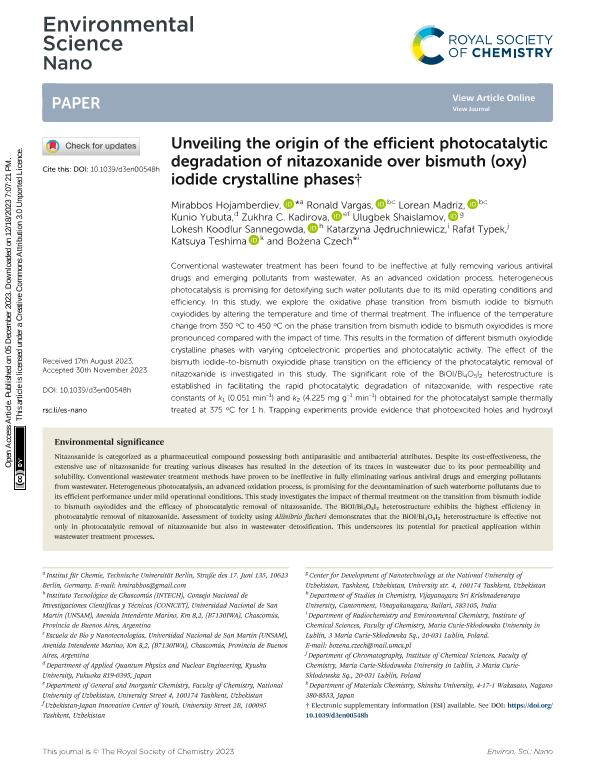Artículo
Unveiling the origin of the efficient photocatalytic degradation of nitazoxanide over bismuth (oxy)iodide crystalline phases
Hojamberdiev, Mirabbos; Vargas Balda, Ronald Eduardo ; Madriz Ruiz, Lorean Mercedes
; Madriz Ruiz, Lorean Mercedes ; Yubuta, Kunio; Kadirova, Zukhra C.; Shaislamov, Ulugbek; Sannegowda, Lokesh Koodlur; Jędruchniewicz, Katarzyna; Typek, Rafał; Teshima, Katsuya; Czech, Bożena
; Yubuta, Kunio; Kadirova, Zukhra C.; Shaislamov, Ulugbek; Sannegowda, Lokesh Koodlur; Jędruchniewicz, Katarzyna; Typek, Rafał; Teshima, Katsuya; Czech, Bożena
 ; Madriz Ruiz, Lorean Mercedes
; Madriz Ruiz, Lorean Mercedes ; Yubuta, Kunio; Kadirova, Zukhra C.; Shaislamov, Ulugbek; Sannegowda, Lokesh Koodlur; Jędruchniewicz, Katarzyna; Typek, Rafał; Teshima, Katsuya; Czech, Bożena
; Yubuta, Kunio; Kadirova, Zukhra C.; Shaislamov, Ulugbek; Sannegowda, Lokesh Koodlur; Jędruchniewicz, Katarzyna; Typek, Rafał; Teshima, Katsuya; Czech, Bożena
Fecha de publicación:
12/2023
Editorial:
Royal Society of Chemistry
Revista:
Environmental Science: Nano
ISSN:
2051-8153
e-ISSN:
2051-8161
Idioma:
Inglés
Tipo de recurso:
Artículo publicado
Clasificación temática:
Resumen
Conventional wastewater treatment has been found to be ineffective at fully removing various antiviral drugs and emerging pollutants from wastewater. As an advanced oxidation process, heterogeneous photocatalysis is promising for detoxifying such water pollutants due to its mild operating conditions and efficiency. In this study, we explore the oxidative phase transition from bismuth iodide to bismuth oxyiodides by altering the temperature and time of thermal treatment. The influence of the temperature change from 350 °C to 450 °C on the phase transition from bismuth iodide to bismuth oxyiodides is more pronounced compared with the impact of time. This results in the formation of different bismuth oxyiodide crystalline phases with varying optoelectronic properties and photocatalytic activity. The effect of the bismuth iodide-to-bismuth oxyiodide phase transition on the efficiency of the photocatalytic removal of nitazoxanide is investigated in this study. The significant role of the BiOI/Bi4O5I2 heterostructure is established in facilitating the rapid photocatalytic degradation of nitazoxanide, with respective rate constants of k1 (0.051 min−1) and k2 (4.225 mg g−1 min−1) obtained for the photocatalyst sample thermally treated at 375 °C for 1 h. Trapping experiments provide evidence that photoexcited holes and hydroxyl radicals play a crucial role in the photocatalytic degradation of nitazoxanide. The photodegradation of nitazoxanide in aqueous solution over crystalline bismuth (oxy)iodide proceeds via hydrolysis into acetylsalicylic acid and the respective aminonitrothiazol, followed by the deacetylation and decarboxylation processes. Molecular dynamics simulation confirms that the high photocatalytic activity of BiOI/Bi4O5I2 is correlated to the higher adsorption energy due to the formation of a network of close contacts (<3.5 Å) between nitazoxanide molecules and iodine atoms.
Palabras clave:
Nitazoxanide
,
Bismuth (oxy) iodide
,
Photocatalysis
Archivos asociados
Licencia
Identificadores
Colecciones
Articulos(CCT - LA PLATA)
Articulos de CTRO.CIENTIFICO TECNOL.CONICET - LA PLATA
Articulos de CTRO.CIENTIFICO TECNOL.CONICET - LA PLATA
Articulos(IIB-INTECH)
Articulos de INST.DE INVEST.BIOTECNOLOGICAS - INSTITUTO TECNOLOGICO CHASCOMUS
Articulos de INST.DE INVEST.BIOTECNOLOGICAS - INSTITUTO TECNOLOGICO CHASCOMUS
Citación
Hojamberdiev, Mirabbos; Vargas Balda, Ronald Eduardo; Madriz Ruiz, Lorean Mercedes; Yubuta, Kunio; Kadirova, Zukhra C.; et al.; Unveiling the origin of the efficient photocatalytic degradation of nitazoxanide over bismuth (oxy)iodide crystalline phases; Royal Society of Chemistry; Environmental Science: Nano; 11; 1; 12-2023; 336-350
Compartir
Altmétricas



